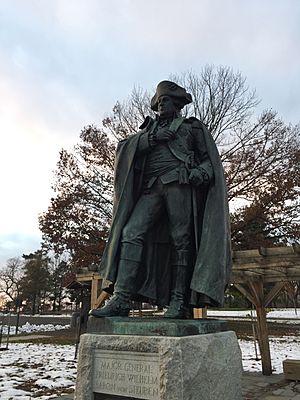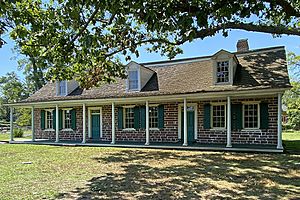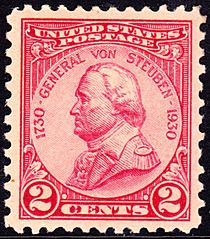Friedrich Wilhelm von Steuben facts for kids
Quick facts for kids
Friedrich Wilhelm von Steuben
|
|
|---|---|
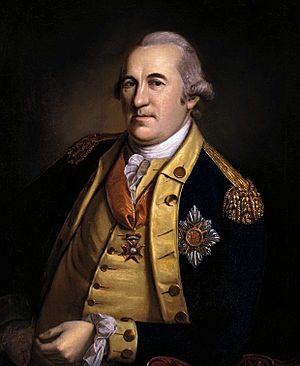
Friedrich Wilhelm von Steuben, by Charles Willson Peale
|
|
| Birth name | Friedrich Wilhelm August Heinrich Ferdinand von Steuben |
| Nickname(s) | Baron von Steuben |
| Born | September 17, 1730 Magdeburg, Magdeburg, Prussia |
| Died | November 28, 1794 (aged 64) Steuben, New York, U.S. |
| Buried |
Steuben Memorial State Historic Site, Remsen, New York, U.S.
|
| Allegiance |
|
| Service/ |
|
| Years of service |
|
| Rank | |
| Battles/wars |
|
| Awards | Cross of the Order of De la Fidelite |
| Signature | |
Friedrich Wilhelm von Steuben (born September 17, 1730 – died November 28, 1794), often called Baron von Steuben, was a Prussian military officer. He played a super important role in the American Revolutionary War. He helped turn the Continental Army into a well-trained and professional fighting force. His work greatly improved how U.S. troops performed in battle. Because of this, he is seen as one of the key figures in creating the United States Army.
Born into a family of soldiers, Steuben learned about war from a young age. When he was 14, he watched his father help direct Prussian engineers during a siege in Prague. At 16 or 17, he joined the Prussian Army, which was known as the best and most disciplined army in Europe. During his 17 years in the Prussian military, Steuben fought in several battles during the Seven Years' War (1756–1763). He rose to the rank of captain and became an aide-de-camp (a personal assistant) to King Frederick II of Prussia, who was famous for his military skills. Steuben even attended Frederick's special school for young officers. He left the army in 1763.
After leaving the Prussian army, Steuben worked for 11 years as a court official for a small German prince. In 1769, he received a special award that gave him the title of 'free lord' or Freiherr. In 1771, he began using the title baron. When the American Revolution started in 1775, Steuben was looking for military work. He couldn't find a job in Europe, so he decided to join the American war effort. He met with American diplomats, including Benjamin Franklin, in France. Because of his military experience and his willingness to help the Americans without pay, he made a good impression on both the Congress and General George Washington. Washington appointed him as a temporary Inspector General of the Continental Army.
Steuben was shocked by the poor condition of the American forces. He took charge of teaching soldiers important military drills, tactics, and discipline, using Prussian methods. He wrote a famous manual called Regulations for the Order and Discipline of the Troops of the United States, which was used by the army for many years and still influences today's U.S. Army manuals. Steuben also helped stop waste and corruption, saving much-needed supplies and money. As his changes started to make a difference in battles, Congress made Steuben the official Inspector General with the rank of Major General in 1778. He spent the rest of the war as Washington's chief of staff and one of his most trusted advisors.
After the war, Steuben became a U.S. citizen. He was given a large piece of land in New York as a reward for his service. In 1780, he became a member of the American Philosophical Society, a group that included many important founding fathers of the nation.
Contents
Baron von Steuben: A Hero of the American Revolution
Friedrich Wilhelm von Steuben was born in the fortress town of Magdeburg in Prussia (which is now part of Germany) on September 17, 1730. His father was a Royal Prussian Engineer Captain. When his father worked for the Empress of Russia, young Friedrich traveled with him to Crimea and Kronstadt. In 1740, Steuben's father returned to Prussia. Friedrich was educated in the towns of Neisse and Breslau by Jesuits. It is said that when he was 14, he volunteered with his father in a military campaign.
Early Military Career in Prussia
Baron von Steuben joined the Prussian Army when he was 17. He served as a second lieutenant during the Seven Years' War in 1756. He was wounded in the Battle of Prague in 1757. He became an adjutant (a staff officer) and was promoted to first lieutenant in 1759. In August 1759, he was wounded again at the Battle of Kunersdorf. That same year, he became a deputy quartermaster at the main army headquarters. In 1761, he became an adjutant to Major General Von Knobloch. He later reached the rank of captain and served as an aide-de-camp to Frederick the Great. In 1762, he was one of 13 young officers chosen for a special training course taught by the king himself.
When the war ended in 1763, the army was made smaller, and Steuben, like many other officers, found himself without a job. He later wrote that a "personal enemy" led to him leaving the Prussian army.
Life in Germany Before America
In 1764, Steuben became a court official for Prince Josef Friedrich Wilhelm of Hohenzollern-Hechingen, a position he held until 1777. In 1769, he received a special award called the Cross of the Order of De la Fidelite. In 1771, he began using the title baron. He traveled to France in 1771, hoping to borrow money, but they returned to Germany in 1775 with many debts.
In 1777, Steuben met Benjamin Franklin in Paris. Franklin was the American ambassador to France. Steuben wanted to join the American army, but Congress was tired of foreign soldiers demanding high ranks and pay. So, Steuben had to agree to go to America as a volunteer and present himself to Congress. Steuben left France on September 26, 1777, on a ship called the Flamand.
Joining the American Revolution
Baron von Steuben arrived in Portsmouth, New Hampshire, on December 1, 1777. He brought his Italian Greyhound dog, Azor, his young assistant Louis de Pontière, and his military secretary, Peter Stephen Du Ponceau. They were almost arrested because Steuben had mistakenly dressed them in red uniforms, which was the color of the British! They were welcomed in Boston. On February 5, 1778, Steuben and his group arrived in York, Pennsylvania, where the Continental Congress was meeting. It was agreed that Steuben would be paid after the war, based on his contributions.
He arrived at Valley Forge on February 23, 1778, and offered to serve as a volunteer. One soldier described the Baron as looking like the "God of War," saying he seemed like a "perfect personification of Mars." The soldier noted his horse's fancy gear, his large pistols, his size, and his strong military look. This soldier believed Steuben would help turn the volunteers into a great army.
Becoming Inspector General
General Washington quickly made von Steuben the temporary inspector general. Steuben went around the camp, talking to officers and soldiers, checking their huts, and looking at their equipment. He set up rules for cleanliness and how the camp should be organized. Before Steuben, there was no set way to arrange tents and huts. People would relieve themselves wherever they wanted, and dead animals were left to rot. Steuben created a plan with rows for commanders, officers, and enlisted men. Kitchens and latrines were placed on opposite sides of the camp, with latrines on the downhill side. This layout became standard for camps.
On May 5, 1778, General Washington suggested to Congress that Steuben be appointed inspector general of the army. Congress agreed, giving him the rank and pay of a major general. Before Steuben, the army's records for supplies, clothing, and soldiers were not well kept. Steuben noticed a lot of "administrative problems" and "war profiteering." He made sure exact records were kept and that strict inspections were done. His inspections helped save the army an estimated five to eight thousand muskets that would have been lost or stolen.
Steuben's Training Program
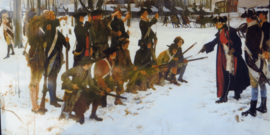
Steuben chose 120 men from different regiments to form an honor guard for General Washington. He used these men to show how military training should be done. These trained men then went on to teach other soldiers in their regiments and brigades. Steuben's unique personality made him even more interesting. He would train the soldiers twice a day in his full military uniform, even though the soldiers themselves often lacked proper clothing.
Steuben could only speak and write a little English. So, he first wrote the drills in German, which was the main military language in Europe at the time. His secretary, Du Ponceau, then translated the drills from German into French. Then, one of Washington's secretaries translated them into English. They did this every night so Washington could use the drills with his soldiers the next morning. Colonel Alexander Hamilton and General Nathanael Greene were very helpful in assisting Steuben with his training program. The Baron's willingness to work directly with the men made him very popular among the soldiers. It was here that he met his close friend, Captain Benjamin Walker, who later became like a son to him. Within weeks, Walker became Steuben's aide-de-camp.
Steuben introduced a step-by-step training system. It started with basic soldier movements, with and without weapons, and then moved on to training entire regiments. This was a big change from the old way of just assigning soldiers to regiments. Each company commander became responsible for training new recruits. The actual teaching was done by sergeants who were specially chosen for being the best.
Earlier in the war, American soldiers mostly used their bayonets for cooking or as tools, not for fighting. Steuben taught them how to use bayonets effectively in charges, which became very important. For example, in the Battle of Stony Point, Continental Army soldiers attacked with unloaded muskets and won the battle only because of Steuben's bayonet training.
The first good results of Steuben's training were seen at the Battle of Barren Hill on May 20, 1778, and then again at the Battle of Monmouth in June 1778. Steuben, who was working at Washington's headquarters by then, was the first to figure out that the enemy was heading for Monmouth.
During the winter of 1778–1779, Steuben wrote his famous book, Regulations for the Order and Discipline of the Troops of the United States, often called the "Blue Book." It was based on the training plan he created at Valley Forge. This book was used by the United States Army until 1814 and influenced U.S. drills and tactics until the Mexican–American War of 1846.
On May 2, 1779, a military review was held to honor the French minister and a Spanish diplomat. Led by General William Smallwood, four battalions performed precise military formations, showing how well they had learned Steuben's training. After the review, about sixty generals and colonels attended a dinner hosted by Steuben.
Southern Campaign and War's End
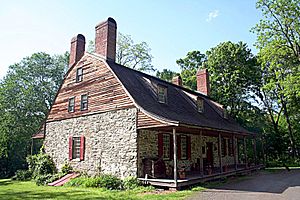
In 1780, Steuben was part of the court-martial (military trial) of British officer Major John André. André was captured and charged with being a spy, working with General Benedict Arnold who had switched sides. Steuben later traveled with Nathanael Greene, the new commander of the Southern campaign. He stayed in Virginia, as U.S. supplies and soldiers would come from there. Steuben helped defend Virginia, with about 1,000 militia fighting a delaying action in the Battle of Blandford. In the spring of 1781, he helped Greene in the campaign in the South. He delivered 450 Virginia soldiers to Lafayette in June.
He had to take sick leave but rejoined the army for the final campaign at Yorktown. There, he commanded one of the three divisions of Washington's troops. In 1783, General Von Steuben helped Washington in taking the army apart after the war. He also helped create a defense plan for the new nation. In May 1783, Steuben helped found the Society of the Cincinnati, a group for officers who served in the war. He was honorably discharged from the military on March 24, 1784.
After the War: Final Years
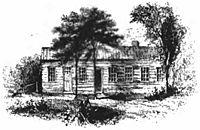
Steuben became a U.S. citizen in March 1784 in Pennsylvania, and later in July 1786 in New York. After the war, Steuben settled with his longtime companion, William North, in New York. He became an important figure in the German Reformed Church. From 1785 until his death in 1794, he was president of the German Society of the City of New York, a group that helped German immigrants.
In 1786, during Shays' Rebellion, Steuben wrote under the name "Belisarius" and criticized the Massachusetts government.
On December 23, 1783, the state of New Jersey gave him the use of an estate in Bergen County, now known as Steuben House. This estate had been taken from a Loyalist family in 1781. The estate included a gristmill and about 40 acres of land. Steuben spent a lot of money to fix the house and get its businesses running again.
On September 5, 1788, the New Jersey Legislature gave Baron von Steuben full ownership of the estate. A month later, because he was having money problems, Steuben wrote to William North, saying the "Jersey Estate must and is to be sold." He eventually sold the New Jersey property to a son of the previous owner. The Steuben House is the only 18th-century building that von Steuben owned that still exists today.
Von Steuben was present at the first inauguration of George Washington in New York in 1789.
Von Steuben later moved upstate to Oneida County, where he had been granted land for his military service. In 1790, Congress gave him a pension of $2,500 a year, which he received until he died.
Personal Life and Death
Von Steuben died on November 28, 1794, at his estate in Oneida County. He was buried in a small forest at what is now the Steuben Memorial State Historic Site. The town of Steuben, New York, was named after him.
Von Steuben never married and had no children. He left his estate to his companions and aides-de-camp, Benjamin Walker and William North. He treated them like his own sons. Another young man, John W. Mulligan, who also considered himself one of von Steuben's "sons," inherited his large library, map collection, and $2,500 in cash.
Steuben's Lasting Legacy
Many cities in the United States celebrate Von Steuben Day in September. It's often considered the biggest event for German-Americans each year. People march, dance, wear German costumes, and play German music. Millions of people attend these events. The German-American Steuben Parade is held every September in New York City. It's one of the city's largest parades and is usually followed by an Oktoberfest celebration in Central Park. The German-American Steuben Parade has been happening since 1958. Chicago also hosts a von Steuben Day parade, which was even shown in the U.S. movie Ferris Bueller's Day Off. Philadelphia has a smaller Steuben Parade as well.
The Steuben Society was started in 1919. It is an organization for American citizens of German background. After World War I, the Society helped the German-American community get organized again. It is now one of the largest groups for Americans of German descent.
A warship, a submarine, and an ocean liner have been named in von Steuben's honor. During World War I, a captured German ship was renamed USS Von Steuben. In World War II, there was a German luxury passenger ship called Dampfschiff General von Steuben, which was used as a transport ship during the war. During the Cold War, the U.S. Navy submarine USS Von Steuben was named after him.
Several places in the United States are named Steuben, mostly in his honor. Examples include Steuben County, New York, Steuben County, Indiana, and the city of Steubenville, Ohio. Many buildings are also named for Steuben, such as Von Steuben Metropolitan High School in Chicago, Illinois, and one of the cadet barracks buildings at Valley Forge Military Academy and College.
Von Steuben was one of four European military leaders who helped the U.S. during the Revolution. He was honored with a statue in Lafayette Square, near the White House, in Washington, D.C.. This statue was dedicated in 1910. A copy was placed in Potsdam, Germany, in 1911, but it was destroyed during World War II. A new copy was given in 1987 to celebrate German-American friendship and the 750th anniversary of Berlin. It was placed in the Dahlem district of Berlin. Another copy is in Steuben's hometown of Magdeburg. Statues of Steuben can also be found in Valley Forge, Pennsylvania, and Utica, New York. There is also an equestrian (on horseback) statue in Milwaukee, Wisconsin. A small statue of Steuben is in the garden of the German Embassy in Washington, D.C.
The Steuben House, which was given to Steuben as a gift for his service, is located at New Bridge Landing in River Edge, New Jersey. The house and the land around it were taken from a Loyalist family in 1781. The house looks much like it did after Steuben fixed it up. The State of New Jersey bought the historic house and one acre of land in 1928. It opened as a public museum in September 1939. The Bergen County Historical Society opens the building for special events. It was added to the National Register of Historic Places in 1970 because of its importance in architecture and military history.
Franciscan University of Steubenville also honors their city’s namesake by having "The Barons" as their team name and mascot.
Other tributes include Steuben Field, the stadium for the Hamilton College football team. Von Steuben helped lay the cornerstone for the school.
Von Steuben has been shown in popular U.S. media. He was played by Nehemiah Persoff in the 1979 TV miniseries The Rebels and by Kurt Knudson in the 1984 TV miniseries George Washington. He was also voiced by Arnold Schwarzenegger in the animated series Liberty's Kids.
In 2007, a documentary DVD called Von Steuben's Continentals: The First American Army was released. This 60-minute film shows the uniforms, camp life, food, weapons, equipment, and drills of the Continental soldier from 1775–1781, as taught by Baron von Steuben.
Images for kids
-
Steuben's grave, Steuben, New York
-
Steuben Monument (1910), Albert Jaegers, sculptor, Lafayette Park, Washington, D.C. There are copies in Germany, at Berlin-Dahlem, Magdeburg and Potsdam
-
Baron von Steuben (1915), J. Otto Schweizer, sculptor, Valley Forge National Historical Park, Pennsylvania. Replica of a statue in Utica, New York.
See also
 In Spanish: Friedrich Wilhelm von Steuben para niños
In Spanish: Friedrich Wilhelm von Steuben para niños



